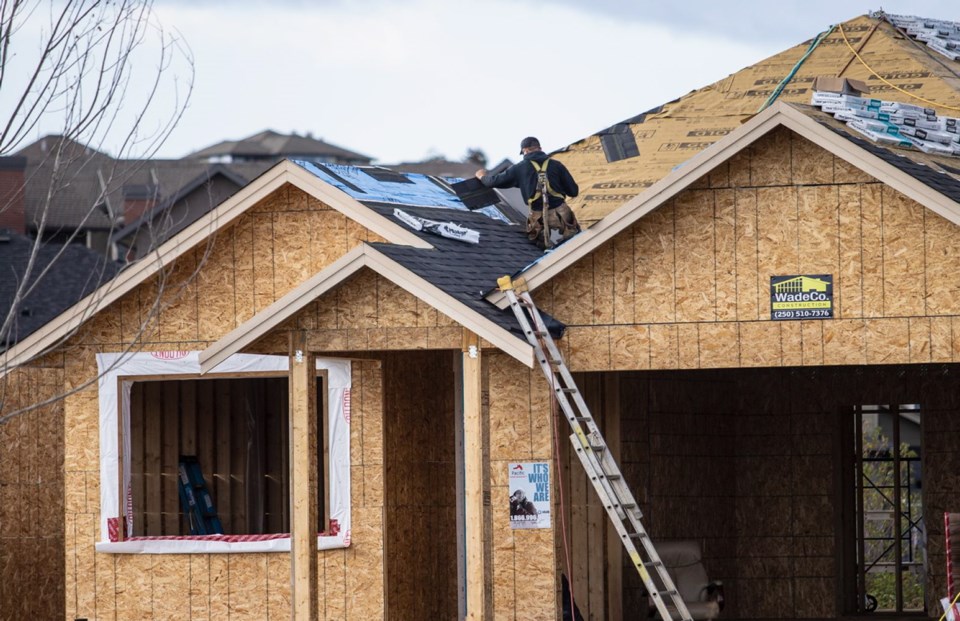Greater Victoria’s homebuilding industry will weather some short-term pain for long-term gain judging by a fall housing outlook released Thursday by Canada Mortgage and Housing Corporation.
The report, which casts an eye out to 2021, said homebuilding is likely to continue to slow down over the next two years before rebounding back to the near-record level reached in 2018.
CMHC market analyst Braden Batch said the fortunes of the homebuilding game are tied to population and employment growth, both of which the CMHC expects to grow at a slower pace in the next few years.
“We are coming off a period of the fundamentals [employment, population growth] being very strong, and they have softened,” he said. “And when you see the fundamentals have changed, other variables have to adjust to those levels. That’s what’s going on in the forecast.”
The CMHC said homebuilding hit a peak of 4,273 new homes started in 2018, while this year it has forecast there will be between 2,800 and 3,418 new homes started, between 2,341 and 3,768 in 2020 and then between 2,723 and 4,099 in 2021.
Batch said the range acknowledges they are unlikely to be able to “hit the nail on the head” of the number of starts and that they are not trying to set any kind of direction for it.
But Casey Edge, executive director of the Victoria Residential Builders’ Association, said it’s more likely a reflection of the fact there is a lot of uncertainty built into forecasting the industry,
To that point, Edge said he takes issue with the CMHC’s assertion that the population growth is slowing or that mortgage rates are likely to increase.
While he agrees there has been a softening of housing starts after last year’s near-record performance, he maintains the draw of Vancouver Island, a diverse and healthy local economy and Canadian immigration policy that calls for increases each year translates into increased demand for housing.
“Bottom line is CMHC are dealing with an uncertain climate, but to me interest rate hikes and slowing population growth are unlikely,” he said. “If we do see a slowing of housing starts that is much more likely to be due to municipalities putting up obstructions to housing than anything else.”
Edge said the large Millennial demographic group remain active in the market, Victoria has one of the lowest unemployment rates in the country and people are still moving to Victoria.
“And we need to meet these people with housing,” he said.
Edge said the CMHC’s numbers speak to a bullish outlook on homebuilding. He said a healthy average year used to mean about 2,200 new homes started, and yet the CMHC forecast is to have at least 2,300 [and up to 4,099] new homes started in each of the next two years.
The outlook also says the real estate market should start to normalize after a slow sales year in 2018.
The forecast suggests there will be as many as 7,378 sales this year, up from the 6,770 in 2018. There were more than 8,400 sales in 2017. And the forecast range in 2020 is for between 5,151 and 7,336 and between 5,088 and 7,273 in 2021.
The CMHC does expect to see continued price growth, but it will be at a moderate pace with more affordable units edging higher, and $1 million-plus homes starting to drop in price.
Batch said the market appears to be moving more in favour of the buyer, after years of sellers being able to dictate terms.
Cheryl Woolley, president of the Victoria Real Estate Board, said the market is adjusting to new mortgage qualification rules and a lack of inventory, both of which have contributed to slower price growth.
“That said, increased sales year-over-year puts pressure on lower-priced homes and condos which are in high demand,” she said. “This means first-time home buyers will likely still see competition and multiple offers in lower-priced brackets, while homes over $1 million have less demand and more available inventory.”
The CMHC outlook also suggests the rental vacancy rate is about to improve for people looking for new homes.
That rate, which hovered below one per cent for years, was 1.2 per cent in 2018 and is forecast to finish this year at 1.5 per cent, hit 1.6 per cent in 2020 and 1.8 per cent in 2021.
That’s down to increased supply.
So far this year, of 2,569 total housing starts, there have been 1,831 new apartments or condos started in the region. And as of this month there are 4,644 condos or apartments under construction, nearly 3,000 of those are purpose-built rental units.
There are also another 8,145 in the planning stages, according to a recent report from Colliers International.
But new supply doesn’t necessarily mean lower rental rates.
The CMHC report suggests because of so much brand new supply hitting the market, rates will actually increase. The average rent for a one-bedroom unit will go from the current $1,076 to $1,175 next year, to $1,282 in 2020 and $1,400 in 2021.
As for suggestions of overbuilding, Batch said Victoria is nowhere near that level.
He did say that absorption could be a risk factor, which could eventually lead to a reduced desire for developers to start new projects.



